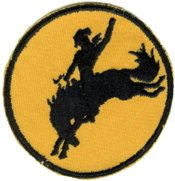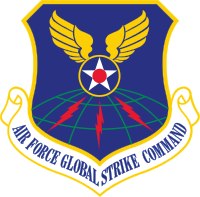436th Training Squadron
| 436th Training Squadron | |
|---|---|
|
Tech. Sgt. Michael Schimpf, 436th Training Squadron, Detachment 20 instructror, trains two individuals on the weapons flightline course, Oct. 4, 2011, at Dyess Air Force Base, Texas. | |
| Active | 1917–1993, 2005-present |
| Country |
|
| Branch |
|
| Role | Training |
| Size | Squadron |
| Part of |
|
| Garrison/HQ | Dyess Air Force Base, Texas |
| Engagements |
|
| Decorations |
|
| Insignia | |
| 436th Training Squadron Emblem |
 |
The 436th Training Squadron (436 TS) is a non-flying training squadron of the United States Air Force. It is a tenant unit assigned to the 7th Operations Group, 7th Bomb Wing, Dyess Air Force Base, Texas[1][2]
The 436 TS is one of the oldest units in the United States Air Force, first being organized as the 88th Aero Squadron on 18 August 1917 at Kelly Field, Texas. The squadron deployed to France and fought on the Western Front during World War I as a Corps observation squadron.[3]
On 7 December 1941, elements of the 88th Reconnaissance Squadron were one of the B-17 Flying Fortress units that landed at Hickam Field, Hawaii during the Japanese attack on Pearl Harbor. Later in World War II as the 436th Bombardment Squadron , the unit earned the Distinguished Unit Citation and the Presidential Unit Citation for its services in the China Burma India Theater (CBI). During the Cold War, it was part of Strategic Air Command equipped with B-52 Stratofortress bombers until its inactivation in 1963.[1]
Overview
The 436th Training Squadron provides formal training to Air Combat Command using 14 classes at Dyess AFB and 38 other programs exported directly to units for local training needs.
Training includes flight, ground and weapons safety, Air Force Operations Resource Management System, classroom instructor training, Aircrew Flight Equipment, and computer software use and development. The 436th Training Squadron also develops multimedia and formal presentations used in training program development and formal presentations. Multimedia personnel are based at Dyess AFB, and deploy worldwide to perform their mission. Unit products and services are used throughout the DOD.
History
World War I
Activated in the summer of 1917 as the Air Service 88th Aero Squadron; deployed to France during World War I and served on the Western Front. Engaged in combat as a corps observation squadron with I, III, IV, and V Army Corps, 30 May – 10 November 1918. After the armistice subsequently served with VII Army Corps in occupation force, November 1918 – May 1919 when the squadron returned to the United States.
Inter-War era
Re-designated as the 88th Squadron in 1921 and assigned to Langley Field, Virginia. Participated in demonstrations of effectiveness of aerial bombardment on warships, June–September 1921. Deployed for service in connection with civil disorders arising from West Virginia coal strike, September 1921. Redesignated 88th Observation Squadron in 1921 the squadron moved from Langley to support Army ground forces at Fort Campbell, Kentucky; then to Texas in 1927 at Brooks Field to patrol the Mexican Border; to Oklahoma in 1928 to support Fort Sill, then back to Brooks Field in 1931.
Squadron moved to California in 1935 and was assigned to the new Hamilton Field near San Francisco, as part of the 12th Observation Group. Became a coastal patrol squadron operating amphibian aircraft, then began to operate modern Martin B-10 bombers in 1936 in the reconnaissance mission when attached as the fourth squadron of the 7th Bombardment Group, 1st Wing, General Headquarters Air Force. The squadron dropped food and supplies and flew photographic missions in connection with flood-relief operations in central California, 12–13 December 1937; upgraded to the B-18 Bolo in 1938, and in 1939 to early-model Boeing B-17B Flying Fortress for long range reconnaissance patrols. Moved to Fort Douglas, Utah in 1940 when the short runways at Hamilton proved inadequate for B-17 operations, with a secondary move to Salt Lake City Army Air Base in January 1941 where it was upgraded to the B-17E.
In October 1941, was ordered to Clark Field, Philippines Commonwealth to build up forces there due to increased tensions between the United States and the Japanese Empire. Due to a lack of planes, some pilots were sent to Seattle to fly new B-17s overseas while the remainder departed on 12 November from Salt Lake City, by train, arriving at Angel Island by ferry; They remained at Angel Island until 20 November, now bound for Hickam Field, Hawaii Territory, on the troopship 'Republic'. The 'Republic' arrived the 28th of November. After an overnight refueling, they reboarded the 'Republic'; just outside Pearl Harbor they joined a convoy of 13 Freighters and an escort of a light cruiser the “Pensacola” bound for the Philippines, this was also known as the 'Pensacola Convoy'. December 7th they had reached the Equator. Hearing the news of the attack on Pearl Harbor, they changed course, from the Philippines, now re-directed to Brisbane, Australia via Suva, Fiji. The B-17s ended up coming in under attack during their arrival at Hickam on 7 December. Some of the planes managed to land at Haleiwa Fighter Strip, one set down on a golf course, and the remainder landed at Hickam under the strafing of Japanese planes.
World War II

After the Pearl Harbor Attack, the surviving aircraft operated from Hawaii until February 1942, becoming part of the air defense forces of the Territory. Moved to Australia with the 7th Bomb Group where the squadron reformed in northern Queensland in late February. Became part of the new Fifth Air Force. Moved to Java in the Dutch East Indies an attempt to stop the Japanese advance, however the small force of B-17s could do very little to stem the tide of the Japanese advance, launching valiant but futile attacks against the masses of Japanese shipping and returned to RAAF Townsville in early March.
Redesignated as the 436th Bombardment Squadron in April 1942 and left its B-17Es in Australia, being reassigned to the new Tenth Air Force in India where it was re-equipped with long-range Consolidated B-24D Liberators. For the balance of the war, carried out long distance heavy bomb raids over Japanese targets primarily in Burma, Thailand and Indochina; a theater with little news coverage, see China Burma India Theater; although also attacked Japanese targets in Southeastern China attacking airfields, fuel and supply dumps, locomotive works, railways, bridges, docks, warehouses, shipping, and troop concentrations in Burma and struck oil refineries in Thailand, power plants in China and enemy shipping in the Andaman Sea. (A more complete account is available in Lt Col (Ret) William Henderson's book, "From China Burma India to the River Kwai") Ceased bombing operations in late May 1945 and was attached to the Air Transport Command to haul gasoline from India over the Himalayas to China. Squadron demobilized in India, leaving B-24s to Indian Colonial forces, inactivated as a paper unit in the United States in early 1946.
Strategic Air Command
Reactivated in 1946 as a B-29 Superfortress bombardment squadron and trained in global bombardment operations flying simulated bombing missions over various cities, as well as performing intercontinental training missions over the Pacific and later to Europe. In June 1948 the first Consolidated B-36A Peacekeeper was delivered. Operated B-36s until 1958 when the squadron began conversion to the B-52 Stratoforterss.
In 1959 was reassigned to SAC provisional 4238th Strategic Wing, being re-equipped with B-52F Stratofortress intercontinental heavy bombers. Was reassigned to Barksdale Air Force Base, Louisiana by SAC to disperse its heavy bomber force. Conducted worldwide strategic bombardment training missions and providing nuclear deterrent. Was inactivated in 1963 when SAC inactivated its provisional Strategic Wings, redesignating them permanent Air Force Wings. Squadron was inactivated with aircraft/personnel/equipment being redesignated 20th Bombardment Squadron in an in-place, name-only transfer.
Modern era
Reactivated in 1986 with the B-52H as the 436th Strategic Training Squadron (436 STS) at Carswell AFB, Texas. The squadron supported the SAC mission through classroom instruction, multimedia production, and training aid fabrication. Due to a realignment of major commands in the Air Force in 1992, the 436 STS became the 436th Training Squadron as a Direct Reporting Unit under Air Combat Command. In 1993, the squadron and the 7th BW moved to Dyess AFB with the realignment of Carswell as a Joint Reserve Base. The squadron is now equipped with the B-1B and continues to function for Air Combat Command providing classroom instruction for over 10 courses to students from every major command and multimedia productions used throughout the DOD.
Lineage


- Organized as the 88th Aero Squadron 18 August 1917
- Redesignated 88th Aero Squadron (Corps Observation), 28 May 1918
- Redesignated 88th Aero Squadron, 27 June 1919
- Redesignated 88th Squadron 14 March 1921
- Redesignated 88th Observation Squadron' 25 January 1923
- Inactivated 1 August 1927
- Activated: 1 June 1928
- Redesignated 88th Observation Squadron (Long-range, Amphibian) 1 March 1935
- Redesignated 88th Reconnaissance Squadron 1 September 1936
- Redesignated 88th Reconnaissance Squadron (Long Range) 6 December 1939
- Redesignated 88th Reconnaissance Squadron (Heavy) 20 November 1940
- Redesignated 436th Bombardment Squadron (Heavy) 22 April 1942
- Inactivated: 6 January 1946
- Redesignated 436th Bombardment Squadron (Very Heavy) 1 October 1946
- Activated: 1 October 1946
- Redesignated 436th Bombardment Squadron (Heavy) 20 July 1948
- Discontinued and inactivated on: 1 April 1963; personnel/aircraft/equipment redesignated as 20th Bombardment Squadron
- Redesignated 436th Strategic Training Squadron 14 February 1986
- Activated on 1 July 1986
- Redesignated 436th Training Squadron 1992
Assignments
|
|
Stations
|
|
Aircraft
|
|
See also
- List of American Aero Squadrons
- United States Army Air Forces in Australia
- List of B-29 units of the United States Air Force
- List of B-52 Units of the United States Air Force
References
![]() This article incorporates public domain material from the Air Force Historical Research Agency website http://www.afhra.af.mil/.
This article incorporates public domain material from the Air Force Historical Research Agency website http://www.afhra.af.mil/.
- 1 2 Maurer, Maurer, ed. (1982) [1969]. Combat Squadrons of the Air Force, World War II (PDF) (reprint ed.). Washington, DC: Office of Air Force History. ISBN 0-405-12194-6. LCCN 70605402. OCLC 72556.
- ↑ Rogers, Brian. United States Air Force Unit Designations Since 1978. Hinkley, England: Midland Publications, 2005. ISBN 1-85780-197-0.
- ↑ Series "E", Volume 9, History of the 72d, 73d, 85th, and 88th-90th Aero Squadrons. Gorrell's History of the American Expeditionary Forces Air Service, 1917–1919, National Archives, Washington, D.C.
- Maurer, Maurer, ed. (1983) [1961]. Air Force Combat Units of World War II (PDF) (reprint ed.). Washington, DC: Office of Air Force History. ISBN 0-912799-02-1. LCCN 61060979.
- Maurer, Maurer, ed. (1982) [1969]. Combat Squadrons of the Air Force, World War II (PDF) (reprint ed.). Washington, DC: Office of Air Force History. ISBN 0-405-12194-6. LCCN 70605402. OCLC 72556.





.jpg)
.png)
.svg.png)